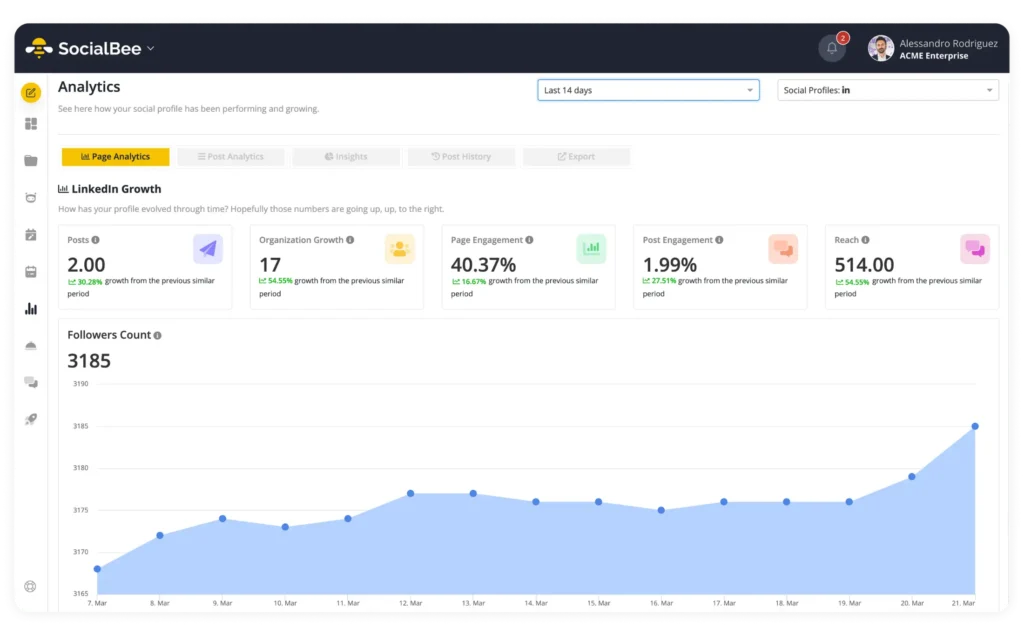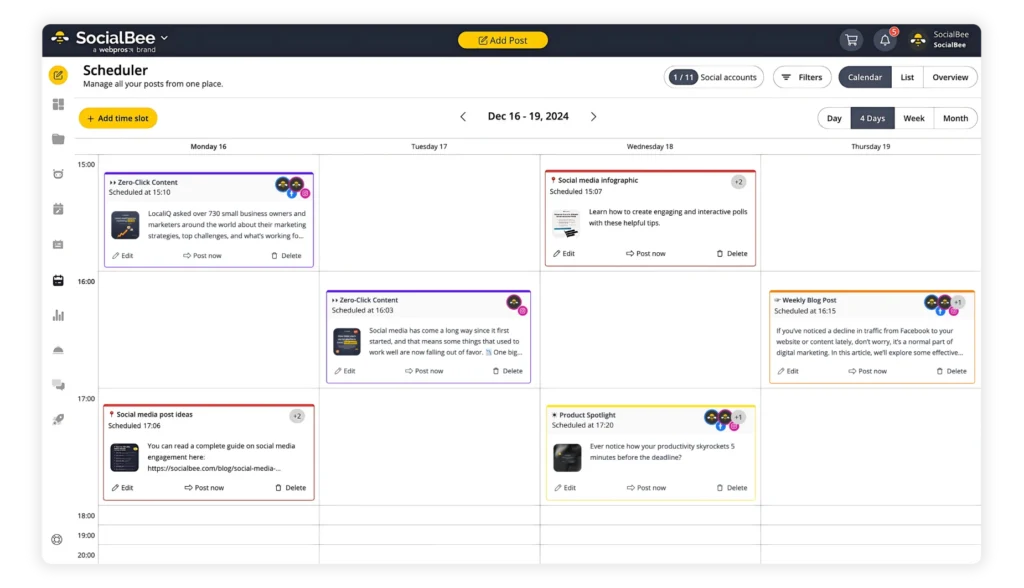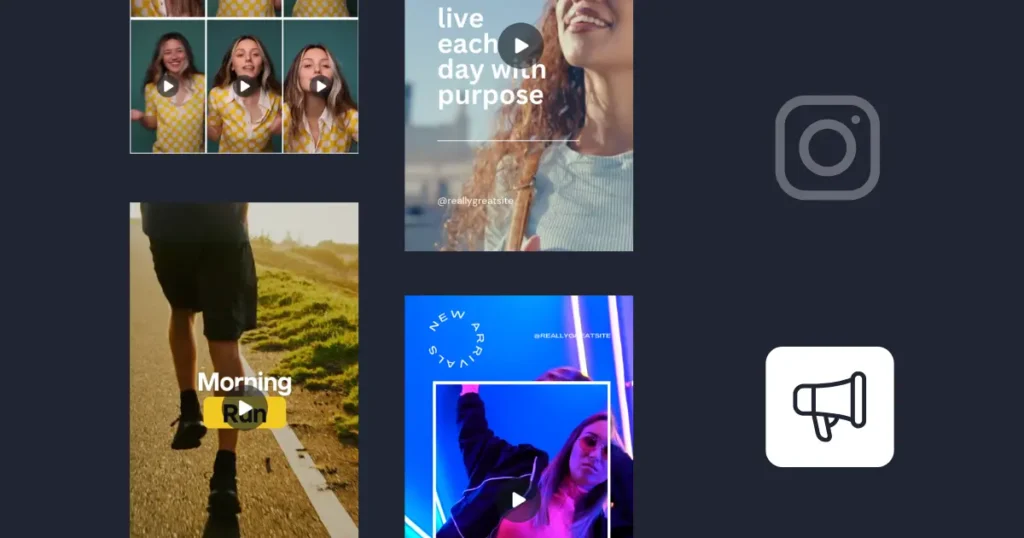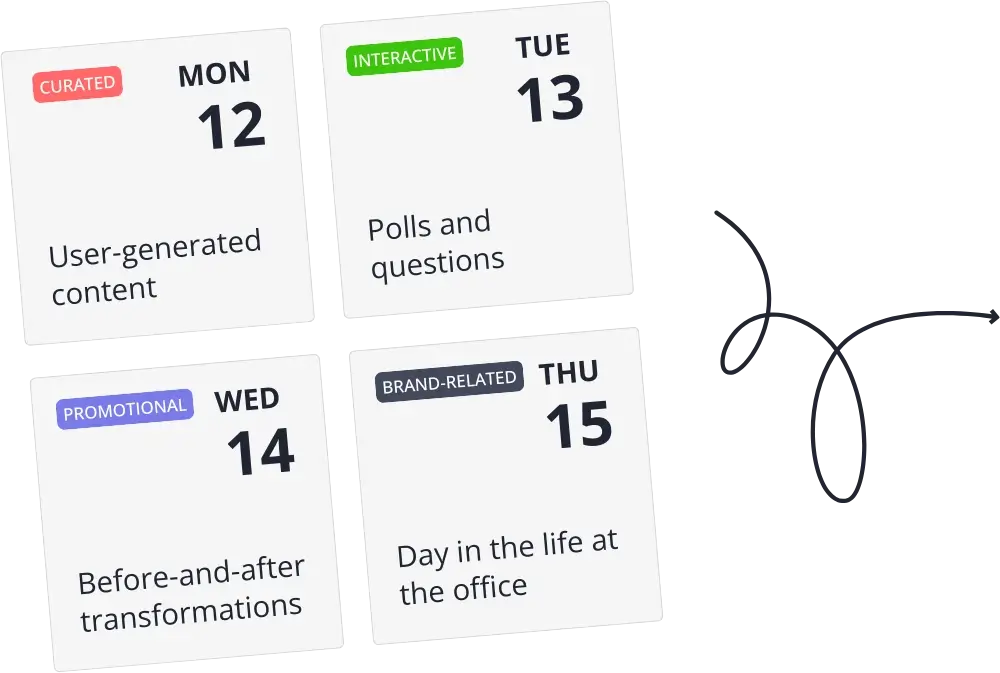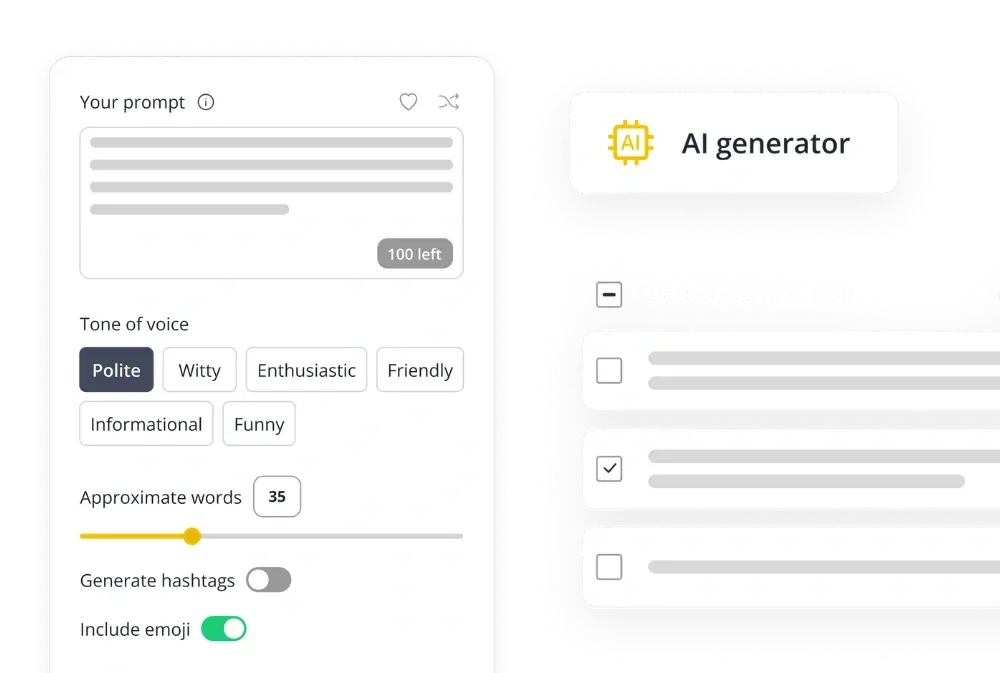
Content Writer at SocialBee
Are you struggling to craft a winning social media management proposal that grabs attention and seals the deal? You’re not alone.
Putting together such a document can be challenging, particularly for those new to the field. If you’re struggling with how to effectively communicate your ideas and align them with your client’s objectives, rest assured, this is a common hurdle.
This guide is your roadmap to creating a proposal that not only shows off your skills but also speaks directly to your potential clients. We’ve also put together a free guide for you: download it and let the magic happen.
Get prospects to trust you with their social media strategy!
We’re SocialBee LABS SRL, part of WebPros. We use the information you provide to share relevant content and product updates, as outlined in our Privacy Policy. You can opt out anytime.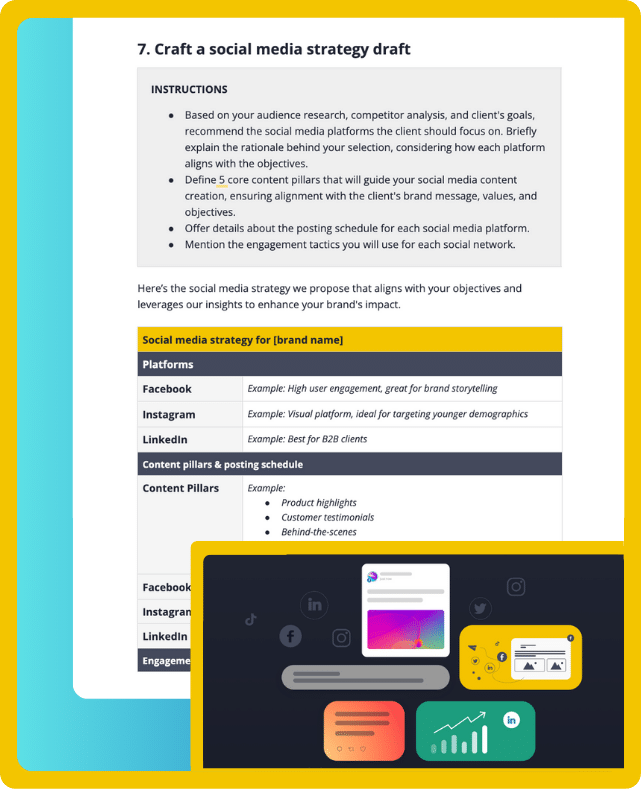
TL;DR
Steps to create a winning social media proposal:
- Start with an engaging executive summary to make a strong first impression.
- Perform a social media audit to assess the client’s current state and identify improvement areas.
- Understand the client’s target audience through detailed market research.
- Conduct a thorough market and competitor analysis to identify trends and opportunities.
- Set SMART (Specific, Measurable, Achievable, Relevant, Time-bound) objectives that align with the client’s business goals.
- Identify client’s needs and problems, and tailor the strategy to address these.
- Draft a clear social media strategy, deciding on platforms, content types, and engagement tactics.
- Establish success metrics and a reporting framework to track and optimize the strategy.
- Include a detailed timeline and implementation roadmap.
- Showcase past work and success stories to demonstrate capability and results.
- Clearly outline budget requirements and payment terms.
- Define the proposal’s terms of service and outline the next steps.
Table of Contents
- What Is a Social Media Proposal?
- How to Create a Winning Social Media Marketing Proposal
- 1. Outline Your Executive Summary
- 2. Conduct a Social Media Audit
- 3. Learn about the Client’s Target Audience
- 4. Conduct Thorough Market and Competitor Analysis
- 5. Set SMART Social Media Objectives
- 6. Identify the Client’s Needs and Problems
- 7. Craft a Social Media Strategy Draft
- 8. Establish Metrics for Success and Reporting Framework
- 9. Outline the Timeline and Implementation Roadmap
- 10. Showcase Proof of Work and Success Stories
- 11. Detail Budget Requirements
- 12. Clarify Proposal Terms of Service and Next Steps
- How to Manage Multiple Clients with SocialBee
- Why Don’t You Give Our Social Media Proposal Template a Try?
- Additional Resources
- Frequently Asked Questions
- Ready to Send Out an Effective Social Media Proposal?
What Is a Social Media Proposal?
A social media proposal outlines the strategy, tactics, and deliverables for managing a client’s social media presence.
It serves as a roadmap for both the social media manager and the client, detailing the goals, target audience, content plan, and metrics for measuring success.
Typically, a social media proposal includes an overview of the client’s current social media presence, an analysis of their competitors, proposed strategies for content creation, community engagement, and advertising, as well as a timeline and budget.
The goal of a social media proposal is to demonstrate to the client how the proposed strategies will help achieve their business objectives. When done right, a killer social media proposal is the first step toward building a strong partnership with your client.
How to Create a Winning Social Media Marketing Proposal
A well-crafted proposal can make all the difference in securing new clients and projects. In this section, we’ll guide you through the essential steps to create social media proposals that not only impress but also effectively communicate your value proposition to potential clients.
1. Outline Your Executive Summary
Whether you’re a seasoned social media marketing agency or a fresh social media freelancer, think of the executive summary as your chance to make a great first impression. It’s where you succinctly share what you’re offering and why you’re the right choice.
This section is your opportunity to shine and quickly communicate your unique selling points. Are you renowned for out-of-the-box campaign ideas, or perhaps you excel at data analysis? Make sure these highlights are front and center.
Here’s what to include in the executive summary of your social media proposal:
- Purpose and promise: Start with a clear statement of what your proposal aims to achieve and the unique benefits you bring to the table. This isn’t just about what you do, but how you make a difference for your client.
- Overview of services: Give a sneak peek into the types of social media services you’re proposing. This isn’t the place for deep details—that comes later.
- What sets you apart: Quickly delve into what makes your approach or your toolkit distinct. This could be your unique strategies, excellent customer service, or your innovative approach to social media engagement.
- Proposal roadmap: Offer a brief outline of the social media proposal template, guiding them on what to expect as they read further.
Important note: Although the summary is the first thing in the proposal, it’s typically written last. This is because it serves as a summary of the content within the entire document.
Writing it at the end ensures that it accurately reflects all the key points and offerings detailed in your proposal, providing a coherent and comprehensive overview right from the start.
2. Conduct a Social Media Audit
A social media audit is an essential step in understanding the current state of a client’s social media presence and setting the stage for preparing to build a strong strategy. This comprehensive review helps identify what’s working, what isn’t, and where there are opportunities for improvement.
Here’s how to run a social media audit for your social media proposal:
- Profile consistency: Ensure that all social media profiles are consistently branded. This means uniform messaging, visuals, and tone across platforms, which helps strengthen brand recognition and ensures the client is easily identifiable wherever their audience engages with them.
- Performance metrics: Dig into the data of existing content. Review engagement rates, reach, and how different types of content perform. Using real data in this analysis helps pinpoint the types of content that connect best with the audience.
- Channel effectiveness: Evaluate which social media platforms are providing the best outcomes. Some might need more focus while others might not be as effective for reaching the intended goals.
- Brand keyword monitoring: Set alerts for mentions of your client’s brand across social media. This helps in managing the brand’s reputation online and spotting both positive engagements and areas that might need damage control.
We’re SocialBee LABS SRL, part of WebPros. We use the information you provide to share relevant content and product updates, as outlined in our Privacy Policy. You can opt out anytime.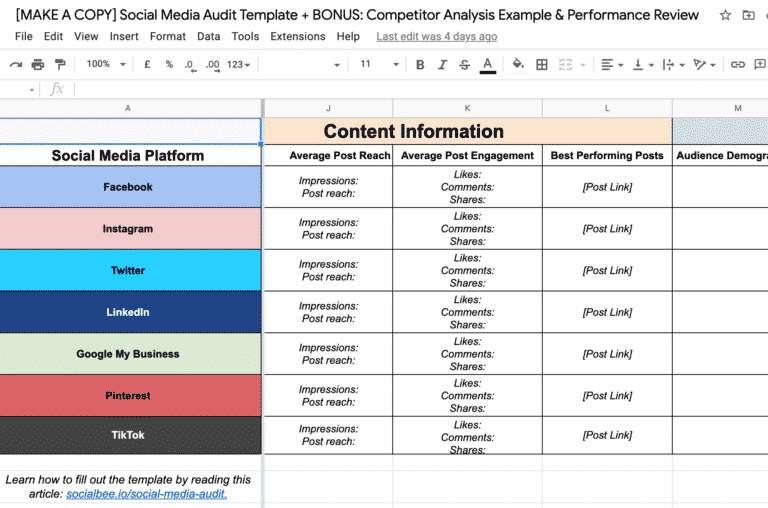
3. Learn about the Client’s Target Audience
Getting to know your client’s target audience is a lot like detective work—it’s all about piecing together who they are, what they like, and how they behave online.
The better you understand these prospective clients, the more effectively you can tailor your social media strategy to meet the client’s business goals. It’s about making every tweet, post, and campaign feel like it was made just for them.
Here’s how you can get a deep understanding of your client’s audience:
- Dive into some market research to scoop up demographic data.
- Take a look at how different types of content are performing on their current social media channels.
- Have a chat with your potential client to get their insights—after all, no one knows their customers better than they do.
4. Conduct Thorough Market and Competitor Analysis
Now that you know their audience, It’s time to see what the competitors are up to and spot the big trends that could influence your client’s social media strategy. This step is all about gathering data that will help your client not just keep up, but really stand out.
What’s buzzing in the industry? Are there new platforms, social channels, or tech updates that are starting to catch on? Getting a handle on these industry trends will help you see where the market is heading and how your client can be at the forefront.
Next, let’s take a closer look at what the main competitors are doing. What types of content are they putting out there? How are their followers responding? This part is essential because it shows you what’s working, what isn’t, and where there might be a gap in the market that your client can capitalize on.
5. Set SMART Social Media Objectives
When setting objectives for your social media proposal, it’s vital to use the SMART criteria—Specific, Measurable, Achievable, Relevant, and Time-bound:
- Specific: Objectives should be clear-cut and precise. Instead of a general goal like “increase brand awareness,” specify what that means. For instance, “increase the brand’s Instagram followers by 20%.”
- Measurable: Each goal must have a corresponding metric that can be measured. This could be the number of new followers, the engagement rate, or click-through rates on ads.
- Achievable: While ambition is important, goals should realistically fit within the limits of your client’s resources and current social media capabilities.
- Relevant: Objectives need to align directly with the broader business goals of your client. If the ultimate goal is to increase sales, social media objectives might focus on driving more traffic to the website or generating leads through social media channels.
- Time-bound: Set deadlines for your objectives to ensure there’s a clear timeline for achieving them. For example, “increase Twitter engagement by 30% within the next quarter.”
In the proposal, you should articulate these SMART objectives clearly. This way, the client can easily see how your proposed social media strategy connects directly to their business goals, driving home the value of your social media expertise.
6. Identify the Client’s Needs and Problems
In the next part, it’s time to show your grasp of the client’s specific challenges through careful listening and a comprehensive needs assessment.
Engage with the client to understand not only the problems they express but also any deeper issues that might not be immediately apparent.
Identify issues like ineffective targeting, low engagement rates, or content that doesn’t connect with the audience. Clearly lay out these challenges to demonstrate that your proposal is tailored to their specific situation.
After pinpointing these areas of concern, show how they affect the overall business.
For example, explain how their low engagement rates might be a missed opportunity for building brand loyalty, or how off-brand messaging could be confusing their customers. This isn’t just about pointing out what’s wrong; it’s about setting the stage for how you’re uniquely equipped to make it right.
7. Craft a Social Media Strategy Draft
As a social media marketer, your role is to draft a proposal that aligns seamlessly with your client’s business goals – thus, you’ll need to pinpoint what is to be developed in the social media strategy.
This involves setting clear objectives for what the strategy aims to achieve—like increasing brand visibility, enhancing engagement, or driving sales. Selecting the right social media platforms is also important; each platform should correspond to where the target audience spends their time and engages most actively.
In your proposal, outline the necessity for a varied content calendar that keeps the audience engaged and reflects the brand’s core messages.
Also, suggest regular engagement tactics that can foster deeper connections with the audience, such as contests or live events.
It’s essential to include a plan for monitoring campaign performance and adjusting strategies based on analytics. This proposal won’t lay out the entire strategy but will set the foundation on which you can build a comprehensive plan.
We’re SocialBee LABS SRL, part of WebPros. We use the information you provide to share relevant content and product updates, as outlined in our Privacy Policy. You can opt out anytime.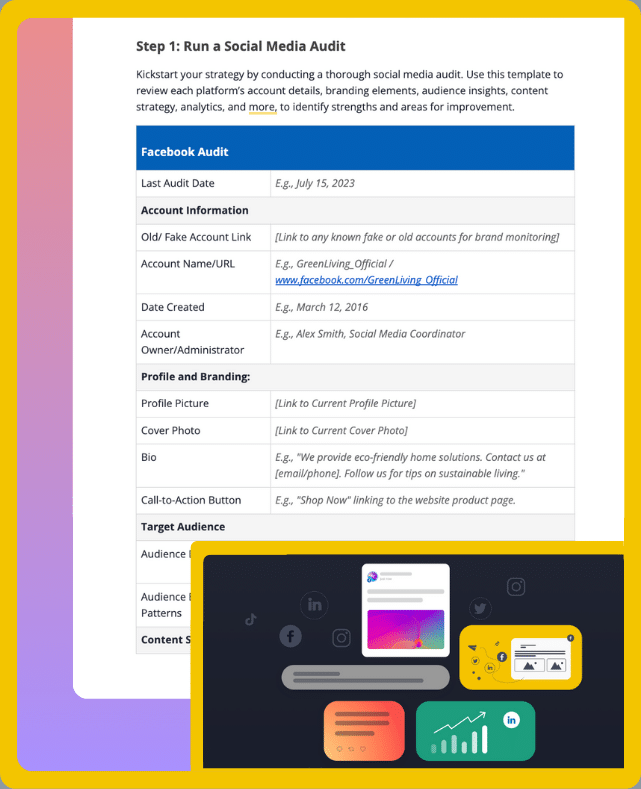
8. Establish Metrics for Success and Reporting Framework
Ensuring the success of your client’s social media strategy requires you to define clear metrics for success and develop a thorough reporting framework. This setup will not only track our progress effectively but also provide insights for ongoing optimization.
Here are some things to consider when reaching the social media monitoring part of your marketing proposal:
- Selecting appropriate KPIs: Choose key performance indicators (KPIs) that align with the business objectives. For boosting brand awareness, focus on metrics like reach and follower growth. For engagement, track likes, comments, and shares. For campaigns driving website traffic, prioritize click-through rates.
- Tools and reporting cadence: Employ advanced analytics tools such as Google Analytics or SocialBee for thorough tracking. Usually, providing monthly reports is best to see how things are going and make any needed changes. However, you can tweak this schedule depending on complex the campaign is.
- Efficient reporting practices: Craft a reporting template featuring visual elements like graphs and charts for clear communication of trends and progress. This approach ensures that the reports are both informative and easy to digest.
Monitor your social media analytics with SocialBee!
Monitoring social media metrics effectively can be a complex and time-consuming task, often requiring you to juggle multiple tools and reports. This is where SocialBee comes in as a solution.
SocialBee gives you a straightforward platform to track your key performance indicators (KPIs). With its built-in analytics, you can effortlessly watch over metrics like reach, engagement rates, follower growth, and click-through rates, all in one spot.
Monitor your social media accounts from SocialBee to improve your performance in real time.
9. Outline the Timeline and Implementation Roadmap
In your social media proposal, be sure to include a detailed project timeline and a step-by-step plan for implementation. This helps set realistic expectations and ensures that everyone is on the same page about what’s happening and when.
Start by breaking down the project into manageable phases, each with specific start and end dates.
Along this timeline, identify key project milestones. They might include the official rollout of the first campaign, or the achievement of the first goal.
These milestones give you checkpoints to assess how the strategy is performing and make any necessary adjustments.
Specify who will manage the posting schedule. For instance, you might state that your team will handle the scheduling and posting of your social media content.
Alternatively, if your prospective clients prefer to have more direct control, you can set up the content for approval through a third-party tool such as SocialBee, where they can review and approve everything before anything goes live.
10. Showcase Proof of Work and Success Stories
Including proof-of-work and success stories in your social media proposal can really set you apart.
It’s one thing to tell potential clients what you can achieve—it’s another to show them. Feature highlights from past campaigns that demonstrate your expertise and the positive impact you’ve made for other clients.
Incorporate client testimonials too. These personal endorsements are incredibly powerful, adding credibility and a human touch to your proposal.
To further strengthen your proposal, include case studies that detail how you’ve tackled past projects and the results you achieved. Adding graphs showing key metrics like follower growth and engagement rates can visually demonstrate the impact of your work.
11. Detail Budget Requirements
When putting together your social media proposal, it’s important to lay out the budget clearly. This ensures everything is transparent from the get-go, and there are no surprises down the line.
Let’s break down the costs: include everything from content creation and management tools to paid ads. It’s helpful to explain each cost—why it’s needed and how it contributes to the campaign’s success—so your client can see exactly where their investment goes.
Don’t forget to mention any monthly fees if you’re offering ongoing management services. Outline what these fees cover, such as continuous content updates, community engagement, and regular performance reports.
Also, it’s a good idea to suggest a contingency fund for unexpected opportunities or needs, like boosting a particularly successful post.
A clear, detailed budget in your proposal not only sets expectations but also shows your professionalism and thorough approach to managing their social media presence effectively.
Include also the payment methods you accept, such as credit cards, bank transfers, and online payments like PayPal. Clearly outline when payments are due, and define any late payment fees to ensure everything is transparent and understood from the start.
12. Clarify Proposal Terms of Service and Next Steps
In the final section of your social media proposal, it’s important to clarify the terms of service and outline the next steps. This ensures that both parties are clear on the agreement details and what is expected moving forward.
Also, define other key terms, such as project start and end dates. Clearly outlining these terms helps prevent misunderstandings and sets a professional tone for the business relationship.
Finish by suggesting clear next steps, such as signing the proposal, scheduling a kick-off meeting, or finalizing any initial payments. This moves the process forward and demonstrates your eagerness and readiness to start delivering results.
How to Manage Multiple Clients with SocialBee
As a social media manager, handling multiple clients’ accounts can become overwhelming. Juggling various posting schedules, aligning with distinct brand voices, and ensuring engaging content for diverse platforms are just a few of the challenges faced.
This complexity requires a streamlined and effective solution to manage workflows efficiently and maintain high standards of content quality. SocialBee comes up as an ideal solution with its AI-powered platform designed to simplify and optimize the management of multiple social media accounts.
Here’s how SocialBee can transform your workflow and elevate your social media management:
- Supported platforms: Seamlessly manage and schedule content across a wide range of platforms including Facebook, Instagram, Threads, X (Twitter), LinkedIn, Pinterest, Bluesky, Google Business Profile, TikTok, and YouTube.
- Universal posting: With SocialBee’s universal posting feature, you can effortlessly share your content across various platforms with just one click. This handy tool helps keep your messaging consistent and saves you time, making it easier to manage your social media presence.
- AI-enhanced tools: Utilize SocialBee’s AI Post Generator to create engaging captions and images, and the Social Media Copilot to strategically tailor your social media approach for each client.
- Social Media Copilot: Take advantage of SocialBee’s Social Media Copilot to enhance your social media strategy. This feature offers practical advice and tailored insights based on your prompts, helping you better connect with your audience and increase engagement on each platform.
- Design integration: Directly design and customize posts using Canva, Unsplash, and GIPHY integrations within the platform, adding visual content without leaving the dashboard.
- Content categories: Organize your content in different folders (content categories)to maintain a balanced mix of posts that cater to different audience interests and campaign goals.
- RSS feeds: Connect the RSS Feed of any blog to automatically import fresh content, keeping your social feeds lively and updated.
- Customization for each network: Tailor your posts for each social media platform to maximize relevance and boost engagement. This ensures your content resonates well with the specific audiences of each site.
- Automatic hashtag generator: Boost the visibility of your posts with SocialBee’s automatic hashtag generator. This tool suggests relevant hashtags, helping your content reach a broader audience and engage with users interested in your topics.
- Content resharing and post expiration: Efficiently manage evergreen and time-sensitive content with options to recycle or expire posts as required.
- Scheduling:Create detailed posting schedules and receive recommendations on the optimal times to share content, based on when your audience is most active.
- Team collaboration and workspaces: Enhance team productivity with multiple workspaces and collaboration tools, allowing for easy communication and streamlined content approval processes.
- Analytics: Monitor the growth of your social media accounts and assess how well your posts are performing. This helps you identify what works best with your audience so you can tailor your content strategy for better results.
- Social Inbox: Stay on top of interactions by responding to comments, DMs and mentions from your followers directly through the platform. This centralized approach makes it easier to engage with your community and build stronger connections.

SocialBee: Your AI-powered social media management tool
Why Don’t You Give Our Social Media Proposal Template a Try?
Figuring out where to start with your social media proposal, what to include, and how to align it with your client’s needs often feels overwhelming. Our template is designed to guide you through the process, ensuring you cover all critical aspects.
It offers a clear structure, reducing the time you spend formatting and allowing more focus on strategy and creativity. It’s designed to be adaptable, making it suitable for any client, from startups to established brands.
Each section prompts you to input specific, tailored information, from audience insights to expected outcomes, making sure your strategy is both comprehensive and compelling.
Get access to our free template below and start creating proposals that not only meet but exceed expectations.
We’re SocialBee LABS SRL, part of WebPros. We use the information you provide to share relevant content and product updates, as outlined in our Privacy Policy. You can opt out anytime.
Additional Resources
- How to Become a Social Media Manager: Expert Tips & Tools
- Top 23 Best Social Media Management Tools for 2024
- The Best Way to Do Social Media Management for Small Business
- The Free Social Media Strategy Template You Need
- 10+ Free Social Media Monitoring Tools for Better Management
- Buyer Personas in Social Media Guide
Frequently Asked Questions
No, a social media strategy proposal is not a contract itself. It’s more like a roadmap outlining the proposed strategies and goals.
Once approved, it can serve as the basis for drafting a formal contract that specifies the terms of the working relationship when delivering your social media marketing services.
To pitch social media management effectively, start by understanding the client’s social media goals and challenges.
Tailor your social media pitch to showcase your expertise and highlight how your services can help them achieve those goals. Provide clear examples of past successes and propose a customized strategy that aligns with their objectives.
Emphasize the potential results they can expect, such as increased brand awareness or engagement. Finally, be confident, professional, and concise in your presentation to win their trust and secure their business.
The standard pricing for social media management services typically starts at around $750 per month. This generally covers managing key platforms such as Facebook and Instagram.
When considering a social media management package, it’s important to understand what’s included in this cost—such as the number of posts per platform, engagement strategies, and any additional analytics and reporting services.
Ready to Send Out an Effective Social Media Proposal?
Crafting a detailed and well-structured proposal not only showcases your professionalism but also sets clear expectations, helping you build trust with prospective clients. With all the components in place, you’re all set to make a compelling case for your services.
Take the next step towards enhancing your social media management by starting your 14-day SocialBee trial today. This will give you a firsthand experience of streamlined content scheduling and management, ensuring you deliver consistent and impactful social media campaigns.


